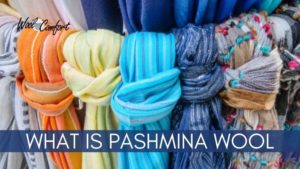Now that you’ve bought or plan to buy your wool carpet, there is something else you must not forget on your list, the cleaning detergents. In order to maintain proper hygiene for your carpet, you must have a cleaning plan for it.
Buying cleaning tools and chemicals is very essential. Compromising on your home hygiene could lead to costly consequences like bacterial infections, dangerous for your health.
The question is, why buy detergents other than soap for your carpet cleaning? I know immediately when you landed on this article, this question popped up in your minds.
First of all, we need to understand what are detergents. These are powerful dilute surfactants purposely made for cleaning. They’re used for domestic scale cleaning at home and even in commercial kitchens.
The application for detergents is unlimited when it comes to where to use them. Whether it’s your windows or your carpets that need to be cleaned, detergents will do an effective job.
Most detergents come from alkylbenzenesulfonates; a family of organic compounds similar to soap but they are highly soluble because of their hydrophilic sulfonate composition, which makes them easily dissolved in water. Detergents have a stronger but non-toxic chemical structure, which makes them very effective in cleaning at home.
Because of their Surfactant ability, they’re able to penetrate and surprise dirt particles by loosening them from the surface, and hence they’re stronger than soaps when getting rid of greasy or oily dirt buildup on your items like carpets or kitchen utensils.
On the other hand, soap contains a carboxylate compound which is highly likely to bond with metal ions like calcium and magnesium found in hard water to form an insoluble curd called ‘precipitate’, which leaves residues when during cleaning.
How are detergents made
Unlikely soap made from saponification of animal fats or vegetable oils (triglycerides), today, most commonly used detergents are made from synthetics. During the process of manufacturing detergents, factors such as human and environmental safety are greatly considered. A process called blending is normally used synthetic ingredients like sodium tripolyphosphate, caustic soda, sulphonic acid, perfume get mixed together into a bigger container. A large quantity of water is then added to an established formula of multiple synthetics after they have been mixed, thus their liquid form.
The effects of chemical-filled synthetic detergents on the ecosystem
Detergents are associated with chemicals, widely known to be toxic to human health and the entire environment. The most used detergents today have been tested and found to have the highest levels of 1,4-dioxane. This chemical compound is widely believed to be toxic to humans and the environment. Based on various studies conducted, 1,4-dioxane causes an irritating effect on some parts of the human body. Just a few hours of exposure to excess 1,4-dioxane can produce eye, nose, and throat irritation on the human being. Furthermore. Decades-long chronic exposure to substances that contain excess 1,4-dioxane compounds may cause damage to the central nervous system, liver, and kidneys in humans.
Studies have also shown that chronic exposure of animals to 1,4-dioxane can cause carcinogenic responses in the liver across multiple species. Although the data available from human epidemiological studies are not adequate to evaluate the relationship between human cancer and chronic exposure to 1,4-dioxane, a 2016 report by US Department of Health and Human Services National Toxicology Program (NTP) found that 1,4-dioxane is “reasonably anticipated to be a human carcinogen based on sufficient evidence of carcinogenicity from studies in experimental animals”. U.S. Environmental Protection Agency has listed 1,4-dioxane as a high priority chemical and classified it as a probable human carcinogen.
Under the Californian Proposition 65 or the Safe Drinking Water and Toxic Enforcement Act of 1986’, dioxane is one of the several chemicals classified to cause cancer.
Detergents’ Toxicity Assessment
In the United States, most detergents and fragrance products manufacturers refuse to disclose the ingredients used in the making of their products by using legal privileges that allow companies to protect their trade secrets. A study conducted by the University of Washington study found out that many top-selling laundry products and air fresheners sold on the market emitted dozens of different chemicals. All the six products they tested gave off at least one chemical regulated as toxic or hazardous under the US federal laws, but none of those chemicals was listed on the product labels.
For your own safety, it is important that you get to know which chemicals have been used to make your favorite cleaning detergent. We have conducted some research and identified the chemicals used by most detergents-makers but flagged off for causing risky effects on human health and the environment when used. If you come across products with the excess composition of these substances, then it is better that you avoid them.
Detergents with sodium hypochlorite compound. Most detergent makers use this chemical compound as an extensive laundry bleaching and disinfectant agent. The health impact which Sodium hypochlorite substance causes depends on its degree of concentration. Although considered to be safe, using sodium hypochlorite beyond normal recommendations can cause serious health implications to your life up to serious risks of mortality. For example, when intentionally or unintentionally swallowed, sodium hypochlorite can cause stomach ache, a burning sensation, coughing, diarrhea, a sore throat, and vomiting. Even exposing it on the skin and in the eyes can cause redness and severe pain. The UN’s Global Harmonized System of Classification and Labeling of Chemicals (GHS) classifies sodium hypochlorite solutions with the following hazardous effects;
- Skin corrosion/irritation (Sub-category 1B)
- Serious eye damage/eye irritation (Category 1)
- Acute aquatic toxicity (Category 1)
- Chronic aquatic toxicity (Category 1)
*Please note, under the GHS’s chemical hazards assessment system, if a substance is classified as ‘category 1’, this means it is highly dangerous or possesses an extreme danger
Detergents spiced with Fragrances: Most of us love detergents with good fragrances but we don’t take time to ask ourselves which ingredients are used to make them. According to the Environmental Working Group (EWG) fragrances are considered to be among the top five allergens and can trigger asthma attacks. Today, over 4,00 chemicals are considered to be used as fragrance ingredients. According to the U.S. Food and Drug Administration 1991 study, 95 percent of these chemicals are derived from petroleum and some are potentially hazardous. In its Material Safety Data Sheets, the US Environmental Protection Agency (EPA) lists the most popular perfume ingredients for having side effects. Some of them include;
- This has been found to be a central nervous system depressant and can cause nausea, dryness of the mouth, and slurred speech.
- Ethanol vapors. Inhalation of ethanol vapors can cause symptoms related to of indigestion.
- Benzaldehyde: This is a narcotic and a local anesthetic.
- Limonene: This is carcinogenic and it’s advisable not be inhaling it.
- Benzyl acetate: This is another carcinogenic substance which has been linked to pancreatic cancer
Many companies that make fragrance products like perfumes or detergents exploit the trade secrecy legal privileges and refuse to disclose the degree of the composition of synthetic chemicals in their products.
Detergents with Phthalates: These are used as solvents or dissolving agents in most detergents. Laboratory tests by the Environmental Working Group (EWG) revealed that 75% of the fragrances contain phthalates. Yet Phthalates have been linked to diabetes, obesity, and hormone disruption which affects both development and fertility. Mt. Sinai Children’s Environmental Health Center, New York has linked exposure to synthetic fragrance in first and third-trimester prenatal exposure to ADHD and autism.
Detergents with sodium Laureth sulfate: Although listed as safe to use in the United States, many products containing Sodium Laureth Sulfate (SLES) also contain traces up to 300 ppm of 1,4-dioxane, formed as a by-product during the ethoxylation step of its production.
Earlier in this article, we’ve talked about 1,4-dioxane for being carcinogenic, meaning that it has the potential to cause cancer. WHO’s International Agency for Research on Cancer has classified 1,4-Dioxane a Group 2B carcinogen: possibly carcinogenic to humans. The United States Food and Drug Administration (FDA) recommends that these levels be monitored, and encourages manufacturers to remove 1,4-dioxane, though it is not required by federal law
The Chemical composition and risk assessment we’ve produced in this blog is not complete as there’re other toxic chemical substances we’re not including here. We highly advise you to be cautious by taking various steps that can keep you away from toxic products.
Taking Precautionary Measures in Advance
The prevalent availability of so many detergents made from life-threatening chemicals entails us to be vigilant, cautious, and curious to know whether they’re safe or not. Here some measures you can take to avoid being a victim;
- Always make sure you read labels sealed on the bottles of these products. The Federal laws require companies that make these kinds of products to put labels like; caution, warning, or danger. Don’t take labels lightly because they’re put there for a reason.
- Do your own background checking regarding how safe is the detergent you want to buy. We’re living in an information age, where you don’t have to be a technical expert to know some things. Sometimes when you curious, you ‘re able to acquire more knowledge on things you didn’t know about.
The Best Organic and NON-Toxic Cleaning Detergents for your Wool Carpet
The increasing uproar against toxic compositions in detergents manufactured by various brands has entailed a drastic shift in adapting to eco-friendly and organic detergents. These detergents are both human and environmentally friendly.
They are made from safe ingredients that pose no danger to human health or the environment. However, it is important to note that many brands are now camouflaging as toxic-free detergents maker, using false labels in order to appeal to the market.
In this article, we’ve compiled a list of certified toxic-free cleaning detergents you can use to clean your wool carpet.
1. Go Organic Laundry Detergents
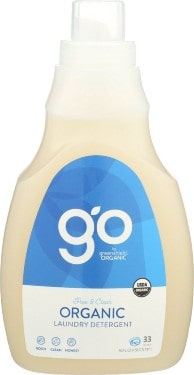 These are some of the safest detergents to use. These detergents are made from ingredients like Sapindus Mukorossi (Organic Soap Berries), Saponified Organic Coconut Oil, Sodium Carbonate, Sodium Bicarbonate, Xanthan Gum, Aloe Barbadensis Leaf Juice Powder (Organic Aloe Vera), Glycerin (Organic), Sea Salt, Cyamopsis Tetragonoloba (Organic Guar) Gum, Acacia Senegal (Organic Acacia) Gum.
These are some of the safest detergents to use. These detergents are made from ingredients like Sapindus Mukorossi (Organic Soap Berries), Saponified Organic Coconut Oil, Sodium Carbonate, Sodium Bicarbonate, Xanthan Gum, Aloe Barbadensis Leaf Juice Powder (Organic Aloe Vera), Glycerin (Organic), Sea Salt, Cyamopsis Tetragonoloba (Organic Guar) Gum, Acacia Senegal (Organic Acacia) Gum.
They’re eco-friendly and safe for people, pets, and the entire ecosystem. Go Organic laundry detergents are Phosphate and Petrochemical Free and are certified under the USDA National Organic Program, making them safer to use.
Pros
- USDA organic certified
- Eco-friendly and safe to use
- Affordable to buy
- Made from organic ingredients
- No disturbing Fragrance
- 100% Vegan (contains no animal-derived ingredients)
- Favorable reviews from Amazon verified buyers
Cons
- The packaging container is plastic
2. Planet 2X Ultra Laundry Detergent
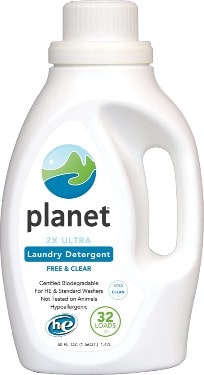 This a 100% Certified biodegradable detergent with ingredients from plant-based sources. It is safe to use by even people’s chemical sensitivities and babies. It doesn’t have unpleasant of toxic fragrances, dyes or other synthetic preservatives
This a 100% Certified biodegradable detergent with ingredients from plant-based sources. It is safe to use by even people’s chemical sensitivities and babies. It doesn’t have unpleasant of toxic fragrances, dyes or other synthetic preservatives
Pros
- Eco-friendly and biodegradable
- Free from toxic fragrances or preservatives
- Can use for various cleaning purposes
Cons
- Domestic shipping within the US is only to APO/FPO addresses.
- Illegible for international shipping
- Relatively expensive
3. Dr. Bronner’s Castile Soap
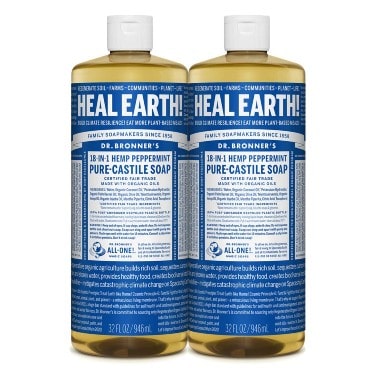 This is one of the most top-selling detergents in the U.S. natural marketplace. Dr. Bronner soap brand has successfully built a reputation for the last 72 years.
This is one of the most top-selling detergents in the U.S. natural marketplace. Dr. Bronner soap brand has successfully built a reputation for the last 72 years.
These soaps are good for just about any cleaning task; Face, body, hair & dishes, laundry, mopping, pets—clean your house and body with no synthetic preservatives, detergents or foaming agents—none!
Pros
- Over 70 years of brand existence
- Highly rated and positively reviewed by buyers
- Made from organic ingredients
Cons
- Very expensive
4. Fit Organic Detergents
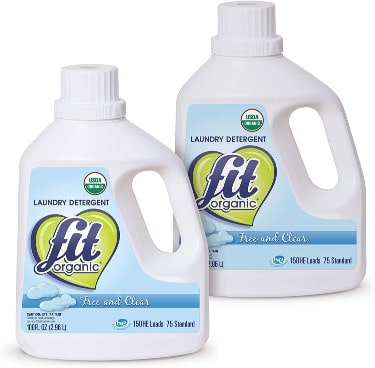 This detergent is also made from organic natural and toxic-free plant-derived materials. It has been certified by USDA and considered to be one of the best organic laundry detergents for laundry and general-purpose cleaning.
This detergent is also made from organic natural and toxic-free plant-derived materials. It has been certified by USDA and considered to be one of the best organic laundry detergents for laundry and general-purpose cleaning.
This detergent is Phosphate-free and is organically made from safe and natural ingredients that pose no risk to your family or pets.
If your skin is sensitive to chemical substance exposure, then you don’t have to worry about this detergent as it has been considered to be safe for use.
It’s also safe to use it when doing laundry for baby clothes and you don’t have to worry about any problem.
The makers of this detergent have made sure that it contains no enzymes, dyes, perfumes, or artificial chemicals that compete with the leading chemical-based laundry detergents.
Pros
- Toxic-free detergent
- Multipurpose
- USDA-Certified Organic
Cons
- Not rated favorably on Amazon
5. Molly’s Suds
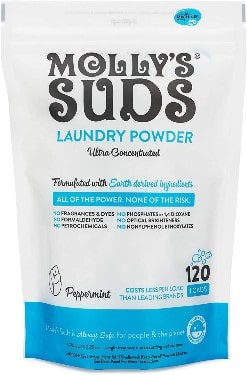 This detergent is super concentrated natural and effective. It is made for those who are chemically sensitive, have sensitive skin, allergies, or eczema.
This detergent is super concentrated natural and effective. It is made for those who are chemically sensitive, have sensitive skin, allergies, or eczema.
It is considered safe for all fabric types except silk and leather – including synthetic, blends, and natural fibers with no risk of fading.
Molly’s Suds laundry detergent is only made from five naturally derived ingredients. It works in all washing machines, water temperatures, hard water, and is septic system safe.
Pros
- Eco-friendly
- No hazardous chemical synthetics
Cons
- Comes in limited bottles
Frequently Asked Questions (FAQs)
Can I use traditional soap instead of detergents to clean my carpet?
Yes, you can use soap to clean your carpet but the most suitable, efficient and preferred way is to use detergents because they’re stronger than soap
Do you sell any detergents on your website?
Nope! We don’t have any detergent we sell as Wool-Comfort. We only research and make reviews on products we think are safe to use and won’t harm your health. However, we also provide links to these products so that you’re able to buy them. It is also important for you to note that our opinions on particular products shouldn’t be considered final, complete or totally accurate
How can I identify the real safest detergent to buy?
Make sure you take the time to read about the product you want to buy. Ask other people who have had experience using it. Scroll down in reviews and read them so that you know what other people are saying. Make use of google search to further find out more.
How can I use the detergent to effectively clean my carpet?
We refer you to this article with a detailed explanation: How to effectively clean your wool carpet

